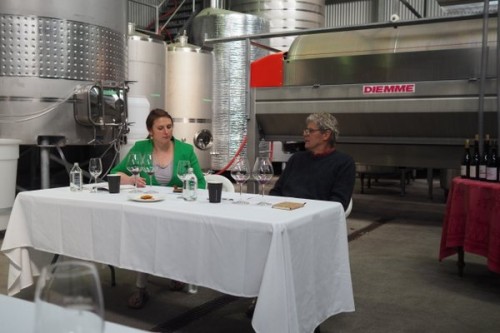
Lucie Lawrence of Aurum and Grant Taylor of Valli led this masterclass, which was held at Aurum. Also present were Matt Dicey (Mount Difficulty and Ceres), Paul Pujol (Prophet’s Rock) and Blair Walter (Felton Road), who contributed to the discussion. The idea was to look at pairs of wines that each tackled topics relevant to Pinot in Central Otago. Specifically, we were asked to focus on the structure of these wines, which all came from the excellent 2013 vintage.
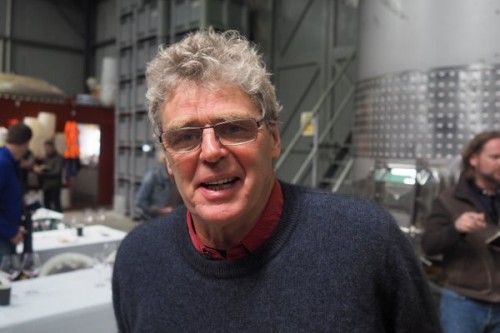
The first pair looked at subregional differences and how they relate to structure: one wine was from the coolest subregion (Gibbston) and one from the warmest (Bendigo). Grant pointed out that Gibbston has 20% lower growing degree days (an approximate metric of growing season warmth, abbreviated GDDs) than Bendigo, which is a big difference.
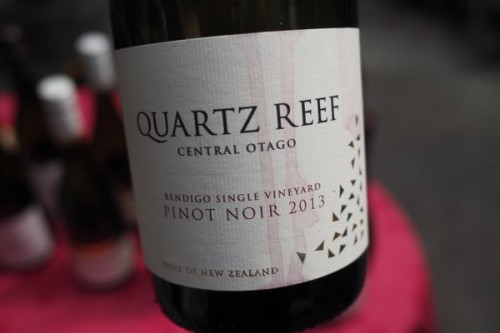
Quartz Reef Bendigo Pinot Noir 2013
Taut, appealing aromatics of red cherries and spice, with some sandalwood hints. The palate has freshness and focus with a savoury, spicy structure underpinning fresh red fruits. Still quite tannic and structured with a dry finish. Has potential for development. 94/100
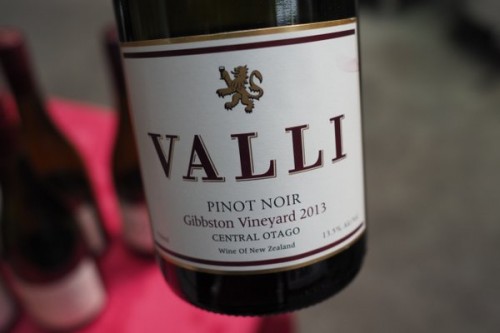
Valli Gibbston Vineyard Pinot Noir 2013
Highly aromatic floral red cherry fruit nose with some savoury spicy notes, and also a touch of green herb character. The palate is very fresh and lively with good acidity and some raspberry brightness, as well as silky cherry fruit. Very fine. 95/100
The structural difference here? The warmer Bendigo region results in a wine that has more tannin in its structure, whereas the structure in the Gibbston wine is a result of tannin and acidity working in concert.
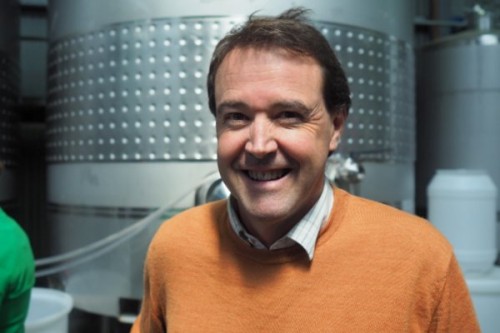
With the second pair, we were looking at vine age, with two wines that were made from vines 21 years and older. Grant pointed out that the average age of a vine in Central Otago is still around 10 or 11 years. These vineyards were planted in 1994 (Maude) and 1992 (Block 3)
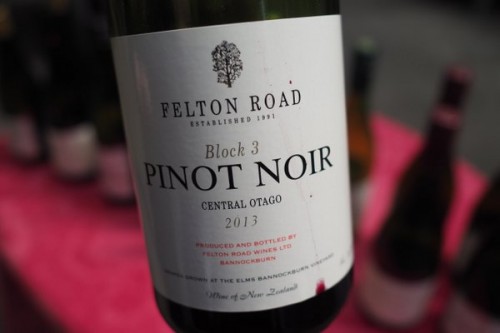
Felton Road Block 3 Pinot Noir 2013
Lovely tight intense raspberry and cherry aromatics with a distinct peppery spiciness. There’s substance and density to the palate which has rich texture and fine, refined tannins. There’s lovely acidity, too. This has beautiful focus and precision: rich and quite ripe but also has presence and structure. Quite profound. 96/100

Maude Mt Maude Vineyard Pinot Noir 2013
Really aromatic with sweetly aromatic red and black cherry fruit. There’s nice floral detail. The palate has generosity and silkiness with sweet, pure berry fruits and fine-grained structure. There’s lovely smooth ripe fruit at the core of this wine, but it also has some mineral characters. So pretty but also with a hint of seriousness. 94/100
There was a lot of discussion about the benefits of vine age. Interestingly, it seems that as vines get older the subregional differences, so evident in young vine Pinot, are less clear. The vine begins to express the site more, and factors such as soil type matter more. Older vines are less prone to seasonal variations, and so you taste the vintage less. You also taste the influence of clone less. Blair Walter commented that as the vines he was working with got older he had to acidify far less, and also towards harvest the sugar never takes off in the same way, so the resulting wines often have lower alcohols. Older vines seem to produce wines where the tannins are better integrated, too.
The third pair was titled the winemaker’s journey, and none of us were really sure what that was about. The first wine is made by Dean Shaw, who wasn’t there, but Matt Dicey gave an elegant account of the journey that he’s taken over the 20 odd years he’s been making wine in Central Otago. When he arrived he was young, and was so excited about the amount of fruit that Central Otago delivered in the Pinot Noir wines. But he wanted structure, too, and so worked the wines hard in the winery. Now he thinks less is more: he doesn’t have to work the wines hard, and he extracts less. But the vines are older and as well as fruit he gets structure, too.
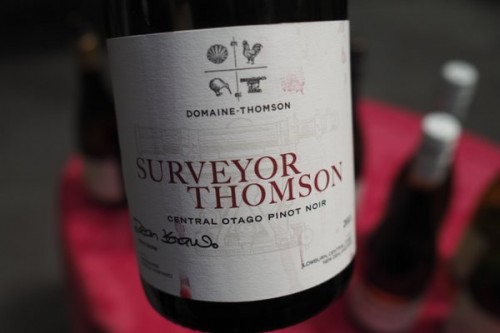
Domaine Thomson Surveyor Thomson Pinot Noir 2013
Very fresh and bright with high acidity and supple, slightly sappy red fruits. There’s a green herbal quality here, along with some grip and juiciness, and a bit of savoury, cedary oak. Very fresh and quite tannic. 93/100

Ceres Composition Pinot Noir 2013
Sweetly aromatic with warm, spicy red fruit characters. There’s a hint of stewed plum and spice here, too. The palate is vivid with sweet cherry and raspberry fruit and some firm, grippy, drying tannins in the background. Some really nice pretty sweeter notes here but also tannic grip. 93/100
The last pair of wines looked at the issue of whole bunch, one of the hot topics in Pinot Noir.
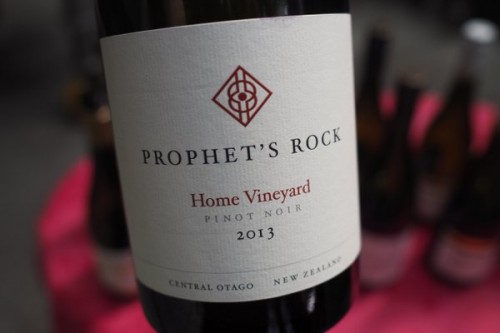
Prophet’s Rock Home Vineyard Pinot Noir 2013
Paul Pujol made five small tanks of this wine. One got no pumpovers or plunging, and had no stems. The rest got one hand plunge, and were in tank for 28-32 days, and again, no stems were used. Lovely aromatics: fresh red cherries, fine herbs, a touch of cedar. The palate is structured and quite firm with good tannins and lovely purity. Very fresh with a bit of tannic bite under the sweet fruit. Lovely focus to this wine. 95/100
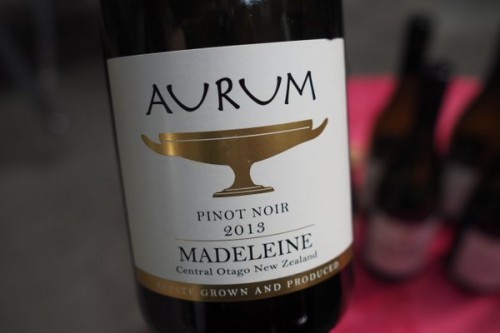
Aurum Madeleine Pinot Noir 2013
Lucie Lawrence uses 100% whole bunch for this wine, which started as an experiment with a ton of 667 clone Pinot that didn’t fit anywhere. This clone always has nice stem ripeness, so Lucie took the tank to the vineyard, picked into the tank, and left the intact bunches, with no juice at all, for 12 day, protected with some gas. After this she threw the children to tread the grapes, and then it started fermenting straight away. The temperature and kinetics of the fermentation was so different. At dryness she basket pressed into old barrels. Fine, fresh, slightly green pot pourri notes alongside the pretty, floral cherry fruit. Nice finesse here. Lovely fresh red fruit quality on the palate and a bit of peppery. Bright with nice grip and elegance. 94/100
This was an interesting tasting with some wide ranging discussion on the direction that Central is going in. Grant, who’s been making wine here for almost 25 years, thinks that the quality has kept going up. As a fairly regular visitor, there’s evident progress. The wines used to taste more similar than they do now, and vine age seems to be helping produce more structured wines that have some non-fruit complexity as well as the delicious sweet fruit that Central delivers so consistently. There are stylistic differences that seem to be emerging too. No doubt the collaborative spirit here, evidenced by the way that producers are so happy to show their wines together and talk openly about them, has helped with the progress that has been made.
Leave a Comment on Central Otago Pinot Noir masterclass, focusing on structure